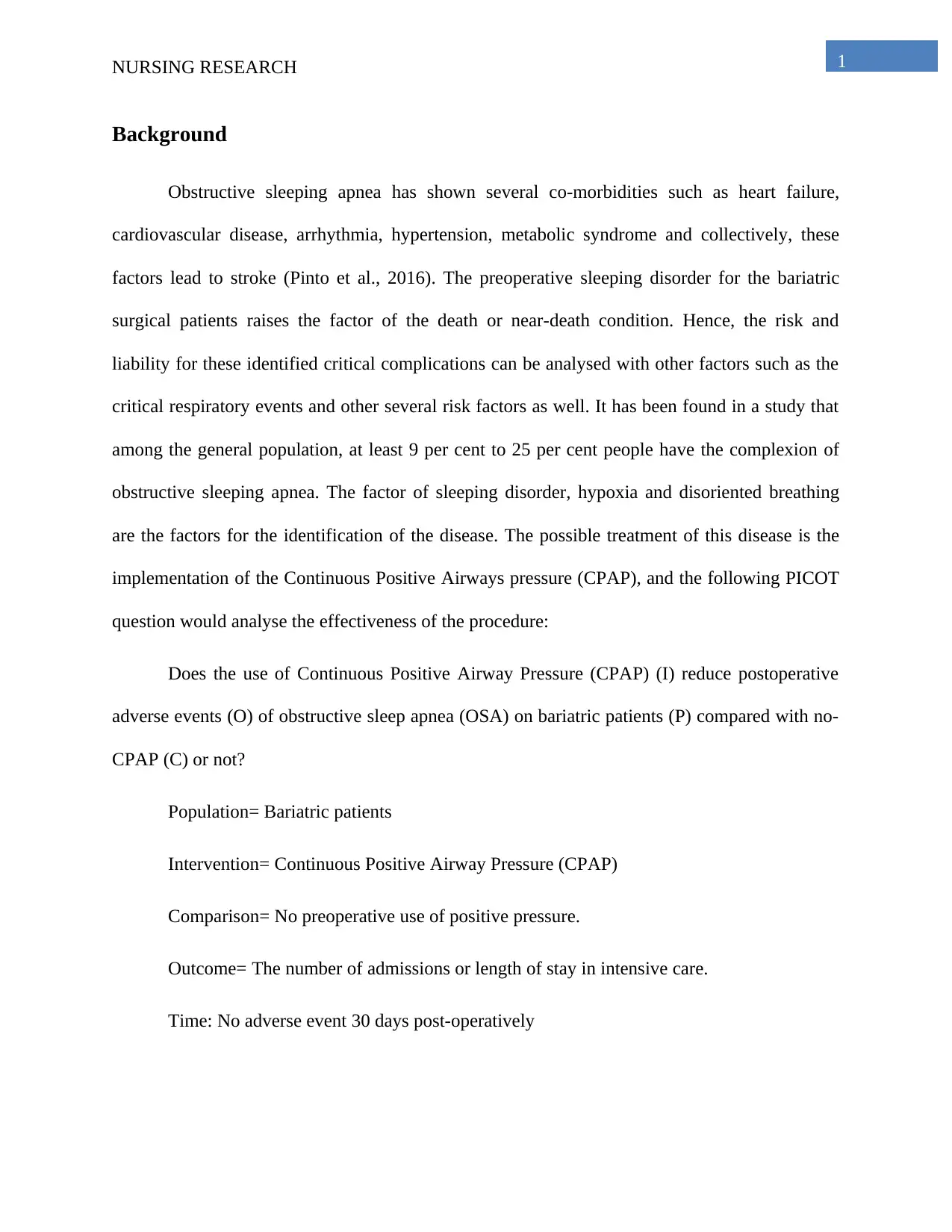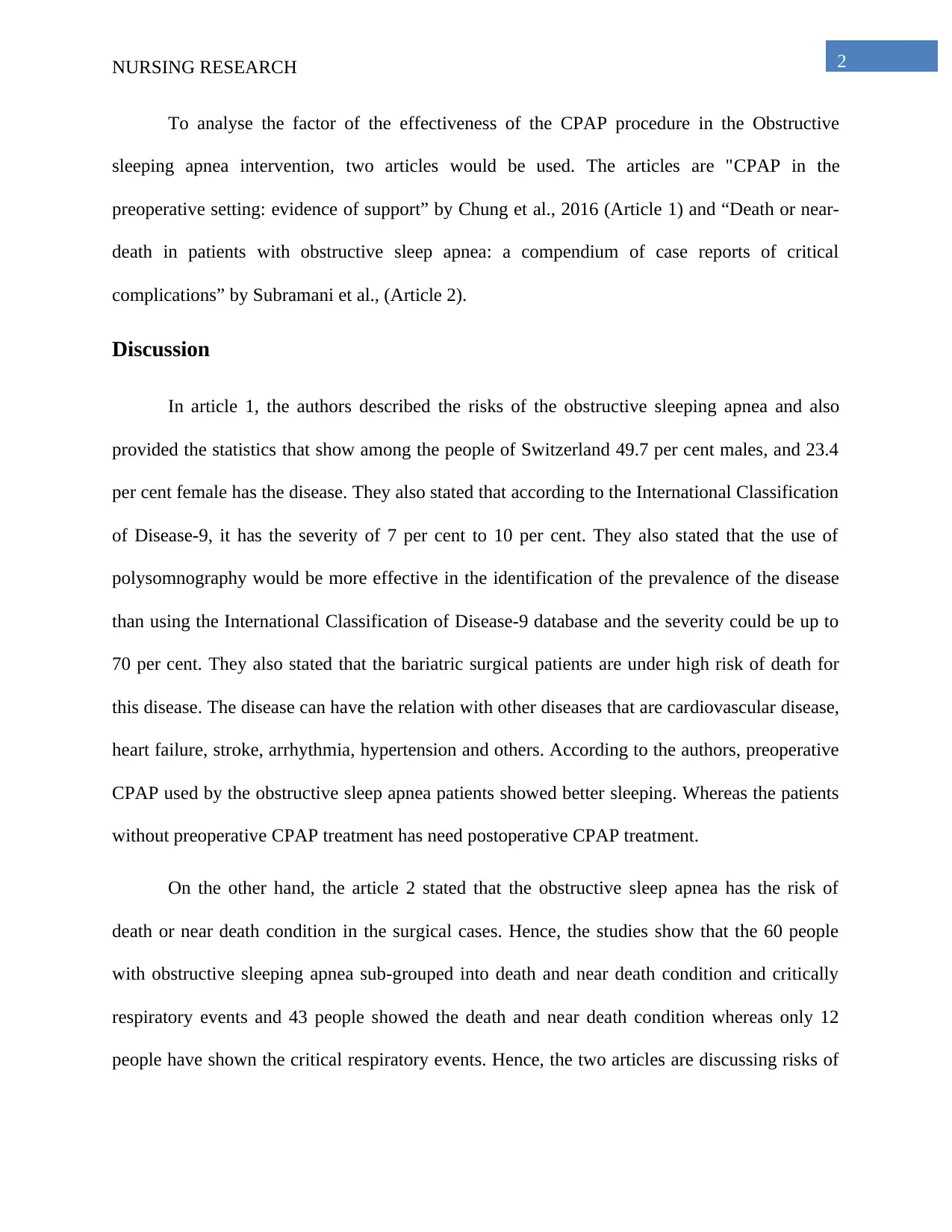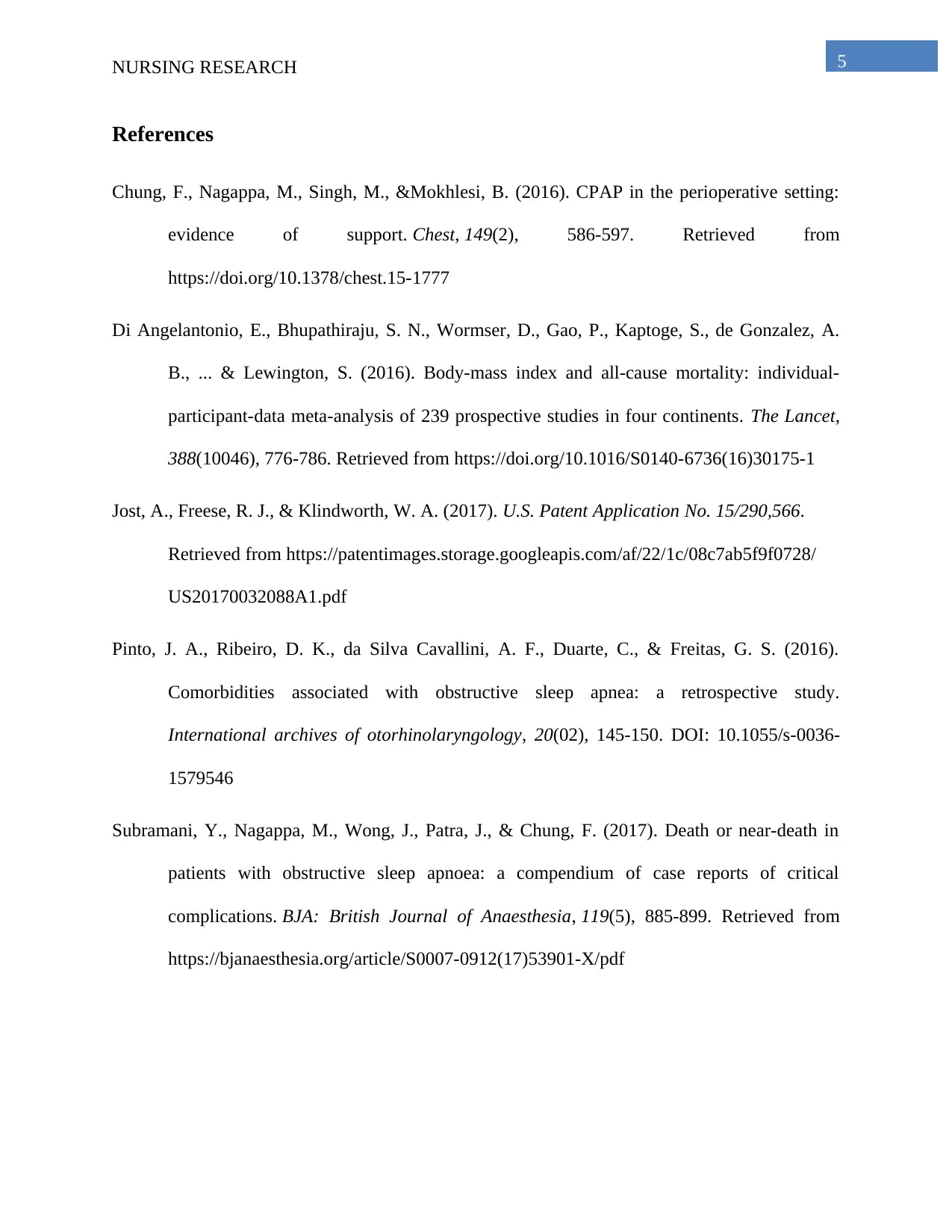Nursing Research 3: CPAP and Postoperative Sleep Apnea Outcomes
VerifiedAdded on 2022/12/22
|7
|1404
|65
Report
AI Summary
This nursing research report critically appraises two quantitative studies concerning the effectiveness of Continuous Positive Airway Pressure (CPAP) in managing obstructive sleep apnea (OSA) among bariatric patients. The research explores the impact of CPAP on postoperative adverse events, comparing it to no-CPAP intervention. The analysis involves a meta-analysis and statistical analysis of data from multiple articles, examining the risks of OSA and the benefits of CPAP. The report discusses the methods used, including meta-analysis and statistical analysis, and presents the results, showing a reduction in complications with preoperative CPAP use. It compares and contrasts the two articles, highlighting their strengths and weaknesses. The studies underscore the importance of CPAP in reducing risks associated with OSA, emphasizing its potential in improving patient outcomes. The report also acknowledges the ethical considerations associated with the studies and their implications for nursing practice.

Running head: NURSING RESEARCH
NURSING RESEARCH
Name of the Student
Name of the University
Author Note
NURSING RESEARCH
Name of the Student
Name of the University
Author Note
Paraphrase This Document
Need a fresh take? Get an instant paraphrase of this document with our AI Paraphraser

1NURSING RESEARCH
Background
Obstructive sleeping apnea has shown several co-morbidities such as heart failure,
cardiovascular disease, arrhythmia, hypertension, metabolic syndrome and collectively, these
factors lead to stroke (Pinto et al., 2016). The preoperative sleeping disorder for the bariatric
surgical patients raises the factor of the death or near-death condition. Hence, the risk and
liability for these identified critical complications can be analysed with other factors such as the
critical respiratory events and other several risk factors as well. It has been found in a study that
among the general population, at least 9 per cent to 25 per cent people have the complexion of
obstructive sleeping apnea. The factor of sleeping disorder, hypoxia and disoriented breathing
are the factors for the identification of the disease. The possible treatment of this disease is the
implementation of the Continuous Positive Airways pressure (CPAP), and the following PICOT
question would analyse the effectiveness of the procedure:
Does the use of Continuous Positive Airway Pressure (CPAP) (I) reduce postoperative
adverse events (O) of obstructive sleep apnea (OSA) on bariatric patients (P) compared with no-
CPAP (C) or not?
Population= Bariatric patients
Intervention= Continuous Positive Airway Pressure (CPAP)
Comparison= No preoperative use of positive pressure.
Outcome= The number of admissions or length of stay in intensive care.
Time: No adverse event 30 days post-operatively
Background
Obstructive sleeping apnea has shown several co-morbidities such as heart failure,
cardiovascular disease, arrhythmia, hypertension, metabolic syndrome and collectively, these
factors lead to stroke (Pinto et al., 2016). The preoperative sleeping disorder for the bariatric
surgical patients raises the factor of the death or near-death condition. Hence, the risk and
liability for these identified critical complications can be analysed with other factors such as the
critical respiratory events and other several risk factors as well. It has been found in a study that
among the general population, at least 9 per cent to 25 per cent people have the complexion of
obstructive sleeping apnea. The factor of sleeping disorder, hypoxia and disoriented breathing
are the factors for the identification of the disease. The possible treatment of this disease is the
implementation of the Continuous Positive Airways pressure (CPAP), and the following PICOT
question would analyse the effectiveness of the procedure:
Does the use of Continuous Positive Airway Pressure (CPAP) (I) reduce postoperative
adverse events (O) of obstructive sleep apnea (OSA) on bariatric patients (P) compared with no-
CPAP (C) or not?
Population= Bariatric patients
Intervention= Continuous Positive Airway Pressure (CPAP)
Comparison= No preoperative use of positive pressure.
Outcome= The number of admissions or length of stay in intensive care.
Time: No adverse event 30 days post-operatively

2NURSING RESEARCH
To analyse the factor of the effectiveness of the CPAP procedure in the Obstructive
sleeping apnea intervention, two articles would be used. The articles are "CPAP in the
preoperative setting: evidence of support” by Chung et al., 2016 (Article 1) and “Death or near-
death in patients with obstructive sleep apnea: a compendium of case reports of critical
complications” by Subramani et al., (Article 2).
Discussion
In article 1, the authors described the risks of the obstructive sleeping apnea and also
provided the statistics that show among the people of Switzerland 49.7 per cent males, and 23.4
per cent female has the disease. They also stated that according to the International Classification
of Disease-9, it has the severity of 7 per cent to 10 per cent. They also stated that the use of
polysomnography would be more effective in the identification of the prevalence of the disease
than using the International Classification of Disease-9 database and the severity could be up to
70 per cent. They also stated that the bariatric surgical patients are under high risk of death for
this disease. The disease can have the relation with other diseases that are cardiovascular disease,
heart failure, stroke, arrhythmia, hypertension and others. According to the authors, preoperative
CPAP used by the obstructive sleep apnea patients showed better sleeping. Whereas the patients
without preoperative CPAP treatment has need postoperative CPAP treatment.
On the other hand, the article 2 stated that the obstructive sleep apnea has the risk of
death or near death condition in the surgical cases. Hence, the studies show that the 60 people
with obstructive sleeping apnea sub-grouped into death and near death condition and critically
respiratory events and 43 people showed the death and near death condition whereas only 12
people have shown the critical respiratory events. Hence, the two articles are discussing risks of
To analyse the factor of the effectiveness of the CPAP procedure in the Obstructive
sleeping apnea intervention, two articles would be used. The articles are "CPAP in the
preoperative setting: evidence of support” by Chung et al., 2016 (Article 1) and “Death or near-
death in patients with obstructive sleep apnea: a compendium of case reports of critical
complications” by Subramani et al., (Article 2).
Discussion
In article 1, the authors described the risks of the obstructive sleeping apnea and also
provided the statistics that show among the people of Switzerland 49.7 per cent males, and 23.4
per cent female has the disease. They also stated that according to the International Classification
of Disease-9, it has the severity of 7 per cent to 10 per cent. They also stated that the use of
polysomnography would be more effective in the identification of the prevalence of the disease
than using the International Classification of Disease-9 database and the severity could be up to
70 per cent. They also stated that the bariatric surgical patients are under high risk of death for
this disease. The disease can have the relation with other diseases that are cardiovascular disease,
heart failure, stroke, arrhythmia, hypertension and others. According to the authors, preoperative
CPAP used by the obstructive sleep apnea patients showed better sleeping. Whereas the patients
without preoperative CPAP treatment has need postoperative CPAP treatment.
On the other hand, the article 2 stated that the obstructive sleep apnea has the risk of
death or near death condition in the surgical cases. Hence, the studies show that the 60 people
with obstructive sleeping apnea sub-grouped into death and near death condition and critically
respiratory events and 43 people showed the death and near death condition whereas only 12
people have shown the critical respiratory events. Hence, the two articles are discussing risks of
⊘ This is a preview!⊘
Do you want full access?
Subscribe today to unlock all pages.

Trusted by 1+ million students worldwide

3NURSING RESEARCH
the obstructive sleep apnea and the effective factors for the eliminating the risks of the disease.
That is why the articles are addressing the factors of the PICOT question.
Method
In article 1, the authors use the method of the Meta-analysis process for the review of the
articles they have taken for the data collection (Di Angelantonio et al., 2016). Factor of the data
about the CPAP usage in the preoperative and postoperative conditions of the obstructive
sleeping apnea patients have been collected utilising article review process. The Meta-analysis
process would analyse the effectiveness of the process. On the other hand, in article 2 the authors
used the statistical analysis process of the data extracted from the reviewed articles. The non-
parametric and the parametric model of statistical analysis were done for the data analysis
process (Jost, Freese & Klindworth, 2017). Hence, the article was based on the quantitative study
of the death and near death conditions of the obstructive sleep apnea patients in the postoperative
period.
Result
In article 1 the authors reviewed ten articles, and the Meta-analysis of those articles
showed that most of the cases the preoperative CPAP usage resulted in the reduction of the
complexion of the disorder in breathing or other co-morbidities. It has also been found that no
CPAP usage resulted in a higher amount of complexion in the postoperative period. However,
one article also showed that there is no significance in the CPAP usage in the intervention of the
Obstructive sleep apnea. On the other hand in article 2 it has been seen that out of all the data, 26
people died, 17 people suffered from anoxic brain injuries and 12 people with other critical
respiration events. Hence, the rate of complexions has been seen 62 per cent among males, and
38 per cent among females and all these complexions are seen among the no CPAP used
the obstructive sleep apnea and the effective factors for the eliminating the risks of the disease.
That is why the articles are addressing the factors of the PICOT question.
Method
In article 1, the authors use the method of the Meta-analysis process for the review of the
articles they have taken for the data collection (Di Angelantonio et al., 2016). Factor of the data
about the CPAP usage in the preoperative and postoperative conditions of the obstructive
sleeping apnea patients have been collected utilising article review process. The Meta-analysis
process would analyse the effectiveness of the process. On the other hand, in article 2 the authors
used the statistical analysis process of the data extracted from the reviewed articles. The non-
parametric and the parametric model of statistical analysis were done for the data analysis
process (Jost, Freese & Klindworth, 2017). Hence, the article was based on the quantitative study
of the death and near death conditions of the obstructive sleep apnea patients in the postoperative
period.
Result
In article 1 the authors reviewed ten articles, and the Meta-analysis of those articles
showed that most of the cases the preoperative CPAP usage resulted in the reduction of the
complexion of the disorder in breathing or other co-morbidities. It has also been found that no
CPAP usage resulted in a higher amount of complexion in the postoperative period. However,
one article also showed that there is no significance in the CPAP usage in the intervention of the
Obstructive sleep apnea. On the other hand in article 2 it has been seen that out of all the data, 26
people died, 17 people suffered from anoxic brain injuries and 12 people with other critical
respiration events. Hence, the rate of complexions has been seen 62 per cent among males, and
38 per cent among females and all these complexions are seen among the no CPAP used
Paraphrase This Document
Need a fresh take? Get an instant paraphrase of this document with our AI Paraphraser

4NURSING RESEARCH
patients. Thus the results clearly state that the CPAP usage in the preoperative situation results in
the reduction of the risk factors of obstructive sleep apnea.
Comparison
The article 1 is an article based on the Meta-analysis process of the data collected from
10 articles on the research of the effectiveness of CPAP on the obstructive sleep apnea patients.
However, the structure of the article was not proper and there is no proper indication of the
results and the methods of the article. Whereas the article 2 is based on the parametric and non-
parametric data analysis of the collected data from the articles on the postoperative risks of the
obstructive sleep apnea patients and the effects of the CPAP usage on these patients. The article
2 is well structured and proper indications of the result and the methods used in the process of
the statistical analysis of the data collected. Hence, the comparison between these articles
showed that article 2 is well structured than article 1.
patients. Thus the results clearly state that the CPAP usage in the preoperative situation results in
the reduction of the risk factors of obstructive sleep apnea.
Comparison
The article 1 is an article based on the Meta-analysis process of the data collected from
10 articles on the research of the effectiveness of CPAP on the obstructive sleep apnea patients.
However, the structure of the article was not proper and there is no proper indication of the
results and the methods of the article. Whereas the article 2 is based on the parametric and non-
parametric data analysis of the collected data from the articles on the postoperative risks of the
obstructive sleep apnea patients and the effects of the CPAP usage on these patients. The article
2 is well structured and proper indications of the result and the methods used in the process of
the statistical analysis of the data collected. Hence, the comparison between these articles
showed that article 2 is well structured than article 1.

5NURSING RESEARCH
References
Chung, F., Nagappa, M., Singh, M., &Mokhlesi, B. (2016). CPAP in the perioperative setting:
evidence of support. Chest, 149(2), 586-597. Retrieved from
https://doi.org/10.1378/chest.15-1777
Di Angelantonio, E., Bhupathiraju, S. N., Wormser, D., Gao, P., Kaptoge, S., de Gonzalez, A.
B., ... & Lewington, S. (2016). Body-mass index and all-cause mortality: individual-
participant-data meta-analysis of 239 prospective studies in four continents. The Lancet,
388(10046), 776-786. Retrieved from https://doi.org/10.1016/S0140-6736(16)30175-1
Jost, A., Freese, R. J., & Klindworth, W. A. (2017). U.S. Patent Application No. 15/290,566.
Retrieved from https://patentimages.storage.googleapis.com/af/22/1c/08c7ab5f9f0728/
US20170032088A1.pdf
Pinto, J. A., Ribeiro, D. K., da Silva Cavallini, A. F., Duarte, C., & Freitas, G. S. (2016).
Comorbidities associated with obstructive sleep apnea: a retrospective study.
International archives of otorhinolaryngology, 20(02), 145-150. DOI: 10.1055/s-0036-
1579546
Subramani, Y., Nagappa, M., Wong, J., Patra, J., & Chung, F. (2017). Death or near-death in
patients with obstructive sleep apnoea: a compendium of case reports of critical
complications. BJA: British Journal of Anaesthesia, 119(5), 885-899. Retrieved from
https://bjanaesthesia.org/article/S0007-0912(17)53901-X/pdf
References
Chung, F., Nagappa, M., Singh, M., &Mokhlesi, B. (2016). CPAP in the perioperative setting:
evidence of support. Chest, 149(2), 586-597. Retrieved from
https://doi.org/10.1378/chest.15-1777
Di Angelantonio, E., Bhupathiraju, S. N., Wormser, D., Gao, P., Kaptoge, S., de Gonzalez, A.
B., ... & Lewington, S. (2016). Body-mass index and all-cause mortality: individual-
participant-data meta-analysis of 239 prospective studies in four continents. The Lancet,
388(10046), 776-786. Retrieved from https://doi.org/10.1016/S0140-6736(16)30175-1
Jost, A., Freese, R. J., & Klindworth, W. A. (2017). U.S. Patent Application No. 15/290,566.
Retrieved from https://patentimages.storage.googleapis.com/af/22/1c/08c7ab5f9f0728/
US20170032088A1.pdf
Pinto, J. A., Ribeiro, D. K., da Silva Cavallini, A. F., Duarte, C., & Freitas, G. S. (2016).
Comorbidities associated with obstructive sleep apnea: a retrospective study.
International archives of otorhinolaryngology, 20(02), 145-150. DOI: 10.1055/s-0036-
1579546
Subramani, Y., Nagappa, M., Wong, J., Patra, J., & Chung, F. (2017). Death or near-death in
patients with obstructive sleep apnoea: a compendium of case reports of critical
complications. BJA: British Journal of Anaesthesia, 119(5), 885-899. Retrieved from
https://bjanaesthesia.org/article/S0007-0912(17)53901-X/pdf
⊘ This is a preview!⊘
Do you want full access?
Subscribe today to unlock all pages.

Trusted by 1+ million students worldwide

6NURSING RESEARCH
1 out of 7
Related Documents
Your All-in-One AI-Powered Toolkit for Academic Success.
+13062052269
info@desklib.com
Available 24*7 on WhatsApp / Email
![[object Object]](/_next/static/media/star-bottom.7253800d.svg)
Unlock your academic potential
Copyright © 2020–2025 A2Z Services. All Rights Reserved. Developed and managed by ZUCOL.





